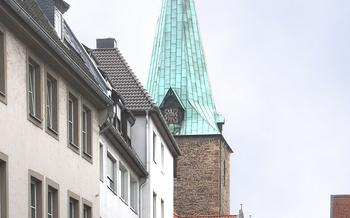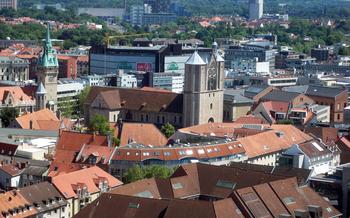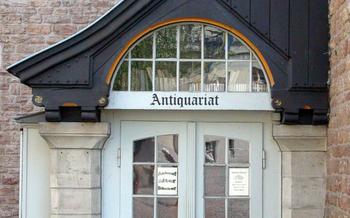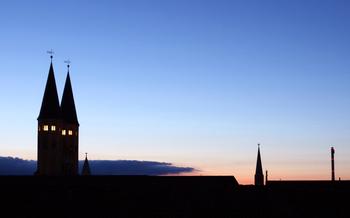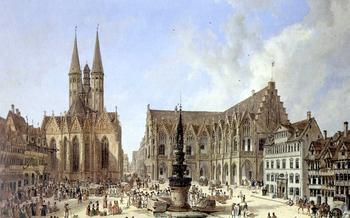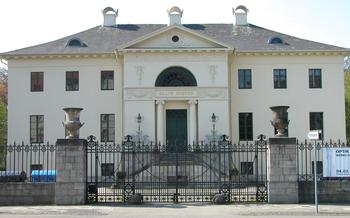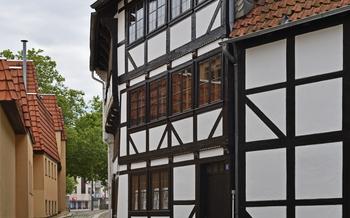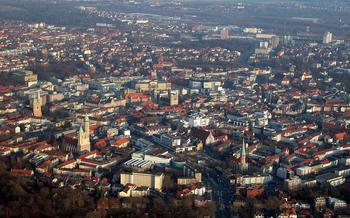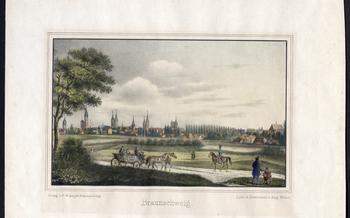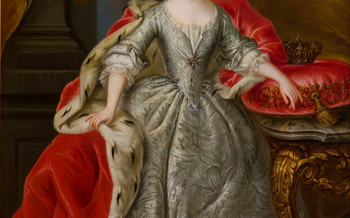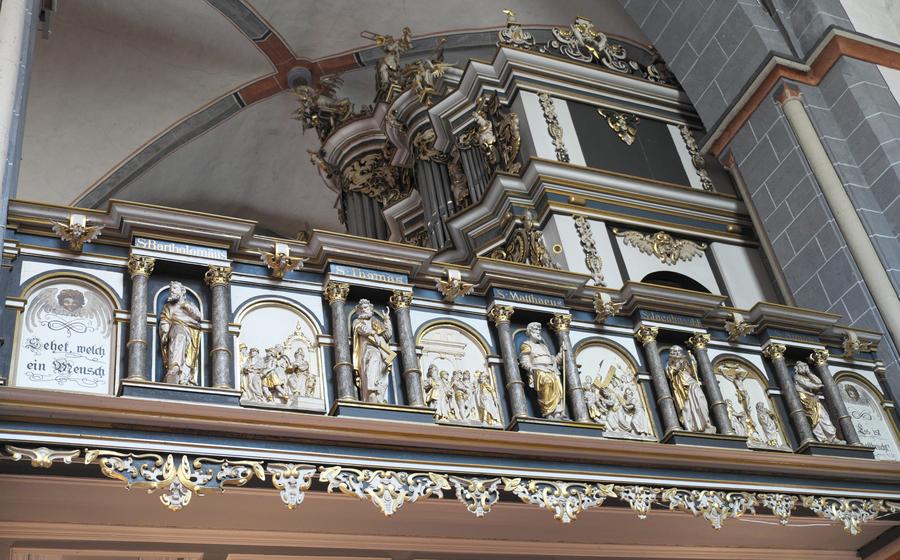
St. Martini Church
- A City of History and Culture
- The St Martini Church: An Architectural Masterpiece
- The History of the St. Martini Church
- The Interior of the St. Martini Church
- The Tower of the St. Martini Church
- The Astronomical Clock
- The Organ of the St. Martini Church
- The Altar of the St. Martini Church
- The Crypt of the St. Martini Church
- The St. Martini Church Today
- Visiting the St. Martini Church
- Things to See and Do Nearby
- Getting to the St. Martini Church
- Tips for Visitors
- Insider Tip
A City of History and Culture
Braunschweig, a city steeped in history and culture, boasts a rich architectural heritage that reflects its medieval and modern influences. As the former capital of the Duchy of Brunswick-Lüneburg, Braunschweig was a center of power and influence, leaving behind a legacy of grand buildings, charming streets, and cultural landmarks.
The city's architectural wonders include the opulent Dankwarderode Castle, dating back to the 12th century, and the majestic Braunschweig Cathedral, renowned for its Gothic spires and intricate carvings. Braunschweig is also home to a vibrant cultural scene, hosting numerous events and festivals throughout the year, including the Braunschweig Classix Festival, showcasing classical music performances in historic venues, and the Braunschweig International Film Festival, attracting filmmakers and movie enthusiasts from around the world.
The St Martini Church: An Architectural Masterpiece
The St. Martini Church stands as a testament to the architectural prowess of the Gothic period. Its soaring spires, intricate carvings, and elegant proportions have earned it a reputation as one of the finest examples of Gothic architecture in Germany. The church's exterior is characterized by its intricate stonework, featuring a profusion of gargoyles, pinnacles, and flying buttresses that add to its dramatic visual appeal. The interior of the church is equally impressive, with its soaring nave, graceful arcades, and stunning stained glass windows that bathe the space in a kaleidoscope of colors. The church's harmonious proportions and exquisite attention to detail create a sense of awe and reverence that is sure to leave visitors spellbound.
The History of the St. Martini Church
The St. Martini Church has a rich and fascinating history that spans over 800 years. Its construction began in the 12th century, and it was completed in the 15th century. The church played a significant role during the Reformation, as it was one of the first Lutheran churches in Germany. Over the centuries, the church has undergone several renovations and additions, resulting in a harmonious blend of architectural styles.
One of the most notable historical events associated with the St. Martini Church is the devastating fire of 1671, which destroyed much of the city of Braunschweig. However, the church itself survived the fire, and it was subsequently rebuilt and restored to its former glory. Another significant event in the church's history is its role in the Braunschweig uprising of 1830, when it served as a gathering place for protesters demanding political reforms.
The Interior of the St. Martini Church
Step inside the St. Martini Church and be awestruck by its grand and awe-inspiring interior. The nave and aisles stretch out before you, supported by rows of towering pillars that seem to reach for the heavens. The air is filled with a sense of reverence and tranquility, inviting you to pause and reflect on the beauty that surrounds you.
Look up and marvel at the stunning stained glass windows that adorn the church's walls. These exquisite works of art depict scenes from the Bible and the lives of saints, casting a radiant glow upon the interior. The intricate details and vibrant colors of the glass create a mesmerizing spectacle that will leave you breathless.
As you explore further, take note of the elaborate carvings and sculptures that grace the church's walls and altars. These intricate works of art depict biblical figures, mythical creatures, and scenes from everyday life, adding a touch of whimsy and wonder to the sacred space. Each piece tells a story, inviting you to delve deeper into the history and symbolism of the church.
The Tower of the St. Martini Church
Soaring high above the cityscape, the tower of the St. Martini Church is a testament to the architectural prowess of the medieval builders. At 92 meters, it dominates the skyline, offering breathtaking panoramic views of Braunschweig and the surrounding countryside. The ascent to the tower is an experience in itself, as the narrow spiral staircase winds its way through the centuries, providing glimpses of intricate details and hidden nooks. Once at the top, visitors are rewarded with unparalleled vistas that stretch for miles, encompassing the city's landmarks, the rolling hills of the Harz Mountains, and the shimmering Oker River meandering through the landscape. The tower's exterior is adorned with delicate tracery, intricate carvings, and gargoyles that seem to come alive against the backdrop of the sky, adding to the church's awe-inspiring presence.
The Astronomical Clock
Among the most remarkable features of the St. Martini Church is its awe-inspiring astronomical clock. Constructed in the 16th century, this mechanical masterpiece is a testament to the ingenuity and craftsmanship of the era.
The clock's intricate mechanism displays the time, date, and astronomical information, including the positions of the sun, moon, and stars. Its moving figures, which include the Three Wise Men, Herod, and an angel, enact a captivating spectacle every hour on the hour.
The astronomical clock is not merely a timekeeping device but also a profound symbol of the church's role in guiding the community through the cycles of life and the cosmos. Its intricate details and moving figures invite visitors to contemplate the mysteries of time, the universe, and our place within it.
The Organ of the St. Martini Church
The St. Martini Church is home to the largest organ in the city of Braunschweig, a magnificent instrument that boasts an impressive size and design, as well as a rich history and cultural significance. Constructed in the 17th century by renowned organ builder Arp Schnitger, this masterpiece features over 4,000 pipes, each carefully crafted and voiced to produce a captivating range of sounds. The organ's intricate carvings and gilded embellishments further enhance its visual appeal, making it a true work of art.
Throughout its long history, the organ has been meticulously maintained and restored, ensuring that its original grandeur and functionality are preserved. It has played a pivotal role in countless religious services, concerts, and cultural events, captivating audiences with its powerful and versatile sound. The organ's deep, resonant tones fill the vast space of the church, creating an atmosphere of awe and inspiration.
In addition to its musical significance, the organ holds a special place in the hearts of the local community. It has witnessed countless milestones and events, such as weddings, baptisms, and memorial services, becoming an integral part of the church's history and traditions. Whether accompanying congregational singing or showcasing the talents of renowned organists, this magnificent instrument continues to enchant and inspire all who hear it.
The Altar of the St. Martini Church
The altar of the St. Martini Church is a central feature of the church and a masterpiece of exquisite craftsmanship. Carved from oak wood and adorned with intricate Gothic details, the altar is a testament to the skill and artistry of medieval craftsmen.
The central panel of the altar depicts the crucifixion of Jesus Christ, with Mary and John standing on either side. The side panels feature scenes from the life of Christ, including his birth, resurrection, and ascension. The altar is a rich and complex work of art that invites visitors to contemplate the life and sacrifice of Jesus Christ.
The altar also holds historical and religious significance. In the 16th century, the altar was a site of conflict during the Reformation. The Protestant reformers wanted to remove the altar, as they believed it was a symbol of Catholic idolatry. However, the Lutherans who had control of the church at the time resisted these efforts, and the altar remained in place.
The altar of the St. Martini Church is a testament to the faith and devotion of the people of Braunschweig. It is a beautiful and inspiring work of art that has stood the test of time, and continues to be a source of inspiration and devotion for visitors to the church.
The Crypt of the St. Martini Church
Beneath the grand interior of the St. Martini Church lies a hidden gem – the atmospheric and enigmatic crypt. This subterranean chamber has served as a burial site for centuries, housing the remains of notable figures from Braunschweig's past.
Descending into the dimly lit crypt is like stepping back in time. The air is cool and still, and the walls are lined with ancient stone sarcophagi and ornate tombs. Each resting place tells a story, whispering secrets of the city's rich history and the lives of those who have shaped it.
Among the most notable figures buried in the crypt is Heinrich the Lion, Duke of Saxony and Bavaria, who founded the city of Braunschweig in the 12th century. His impressive tomb, adorned with intricate carvings and sculptures, stands as a testament to his power and influence.
Another notable resident of the crypt is Elisabeth of Brunswick-Lüneburg, Duchess of Brunswick-Wolfenbüttel. Known for her piety and charitable works, Elisabeth was a beloved figure in her time. Her tomb, a masterpiece of Gothic art, features a serene effigy of the duchess, surrounded by intricate carvings depicting scenes from her life.
Visiting the crypt of the St. Martini Church is a unique and immersive experience that offers a glimpse into the city's fascinating past. As you wander through the dimly lit corridors, surrounded by the echoes of history, you can't help but feel a sense of awe and reverence for the lives that have been lived and the stories that have unfolded within these ancient walls.
The St. Martini Church Today
The St. Martini Church remains an active Lutheran congregation, hosting regular church services and attracting a diverse and dedicated community of worshippers. Its enduring religious significance is deeply intertwined with the cultural and historical identity of Braunschweig. Beyond its spiritual purpose, the church also serves as a prominent cultural and historical landmark, drawing visitors from around the world who come to admire its architectural splendor and rich history. The St. Martini Church stands as a testament to the enduring legacy of faith, artistry, and community that has shaped Braunschweig throughout the centuries.
Visiting the St. Martini Church
The St. Martini Church welcomes visitors with open arms, offering a glimpse into its rich history and architectural splendor. Opening hours are generous, allowing ample time for exploration. Admission fees are modest, ensuring accessibility to all.
Self-guided tours provide a flexible way to discover the church's many treasures, while guided tours offer a deeper dive into its fascinating history and symbolism. Accessibility is a priority, with ramps and elevators facilitating navigation for those with limited mobility.
Restrooms and a small gift shop cater to visitors' convenience. Whether you're a history buff, an architecture enthusiast, or simply seeking a moment of quiet contemplation, the St. Martini Church offers a welcoming and enriching experience.
Things to See and Do Nearby
The St. Martini Church is located in the heart of Braunschweig's historic city center and is surrounded by a wealth of other attractions, historical landmarks, and cultural venues. Just a short walk away, visitors can explore the imposing Braunschweig Cathedral, with its distinctive green domes and Romanesque architecture. The Dankwarderode Castle, an imposing medieval fortress turned museum, is another must-see, showcasing a collection of historic artifacts and exhibits.
For those interested in art and culture, the Herzog Anton Ulrich Museum is a treasure trove of paintings, sculptures, and decorative arts, while the Städtisches Museum Braunschweig offers a fascinating journey through the city's history and development. Braunschweig is also renowned for its vibrant shopping scene, with the pedestrianized shopping streets of the Innenstadt, lined with boutiques, specialty shops, and department stores, offering a delightful retail experience.
When it comes to dining, Braunschweig offers a diverse culinary scene, from traditional German cuisine to international flavors. Whether it's savoring a hearty schnitzel at a cozy tavern or indulging in international delicacies at a trendy restaurant, visitors can find a wide range of dining options to satisfy their taste buds.
Getting to the St. Martini Church
The St. Martini Church is conveniently located in the heart of Braunschweig, making it easily accessible by various transportation modes. While self-exploration is encouraged, guided tours are also available, offering insights into the church's rich history and architectural details.
For those utilizing public transportation, the city's efficient bus and tram network provides direct access to the church's doorstep. The nearest bus stop is "St. Martini-Kirche," located just steps from the church's entrance, while the closest tram stop is "Wendenstraße," a short walk away.
Driving to the church is also an option, with several parking garages and street parking spaces available in the vicinity. However, it's essential to note that Braunschweig's city center is predominantly a pedestrian zone, and parking restrictions may apply.
For those who prefer a more active approach, the St. Martini Church can be conveniently reached on foot or by bicycle. Pleasant walking and biking routes lead directly to the church, offering a chance to explore the city's charming streets and architecture en route.
Tips for Visitors
When visiting the St. Martini Church, it is important to be mindful of a few things to ensure a respectful and enjoyable experience.
-
Dress appropriately: While there is no strict dress code, it is advisable to dress modestly and respectfully, as the church is an active place of worship.
-
Be respectful of religious services: If you visit during a service, be quiet and refrain from taking photographs or talking loudly.
-
Take your time to explore: The St. Martini Church is a treasure trove of history and art, so take your time to explore its many features, including the intricate carvings, stunning stained glass windows, and the impressive astronomical clock.
Insider Tip
For an unforgettable experience, climb the tower of the St. Martini Church and take in the breathtaking panoramic views of Braunschweig and the surrounding countryside. The ascent may require some effort, but the reward is unparalleled. Marvel at the intricate details of the tower's architecture as you make your way to the top. Once you reach the observation deck, you'll be greeted by a stunning vista that will leave you in awe.
Another insider tip is to attend a concert or organ recital held within the church's hallowed halls. The acoustics of the St. Martini Church are renowned, and the opportunity to hear talented musicians perform in such a majestic setting is not to be missed. Let the harmonious sounds wash over you as you soak in the beauty of your surroundings.
Finally, if you happen to visit Braunschweig during the festive season, make sure to experience the annual Braunschweig Christmas Market. Held in the heart of the city, just a stone's throw from the St. Martini Church, this enchanting market offers a magical blend of traditional German Christmas cheer, delectable treats, and unique handcrafted gifts. Immerse yourself in the festive atmosphere and let the spirit of the season fill your heart.
